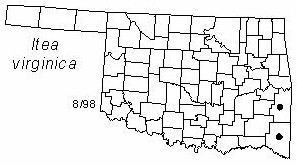Shrub to 3 m (10 ft) tall. Crown spreading. Bark brown to gray, smooth and scaly. Twigs green, turning brown with age; slender, pubescent, becoming glabrous with age. Leaves alternate, simple, oblong, elliptic or oval, mostly glabrous, dull green above, 2-9 cm (0.8-3.5 in) long and 1-4 cm (0.4-1.6 in) wide, pubescent; cuneate at base; acute or acuminate at apex, finely serrate, turning dull green above in fall. Flowers numerous in terminal racemes, pubescent, about 4 mm (0.15 in) wide; sepals 5, pubescent, lanceolate to acuminate; petals 5, white or pink, linear to lanceolate, slender; stigma 2-lobed, ovary 2-celled, superior; stamens 5, as long as petals, flowers appear April to June. Fruits capsules, about 8 mm (0.3 in) long, oblong, brown at maturity.
Distribution: eastern Oklahoma, and Texas, east to Florida, north to New Jersey, and west to Missouri. Uncommon in Oklahoma; limited to the Ouachita Mountains and Gulf Coastal Plain.
Habitat: streambanks and swamp margins in acid soil.
NWI status: FACW+, OBL
Comments: Itea is the Greek for willow; virginica refers to the state of origin of the first described collection. There is only one species of Itea in North America, but 15 in Asia.
Horticulture: The showy, fragrant flowers of Virginia sweetspire make it an excellent ornamental species. Cuttings root readily. When planting, select a lightly shaded area with moist soil.
Distribution in Oklahoma: 
BACK
NEXT
RETURN TO INDEX
Last update: 9/10/99
 Go to Oklahoma Biological Survey Home Page
Go to Oklahoma Biological Survey Home Page
 Disclaimer
Disclaimer